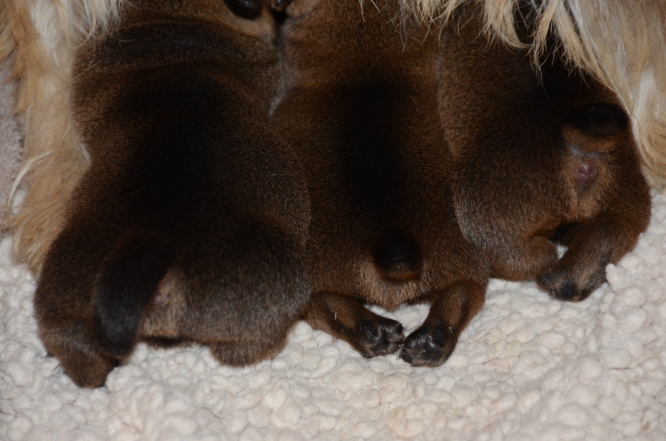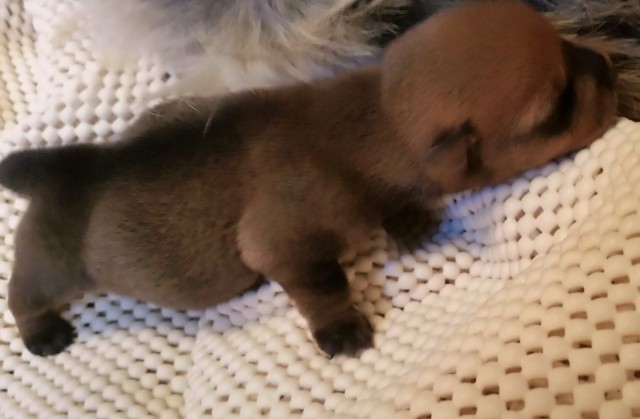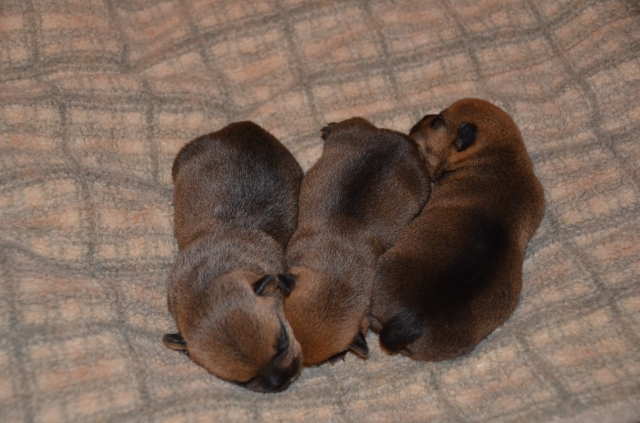Hip Dysplasia – Nature/Nurture Side of Things
Hip dysplasia is one of those conditions that all dog breeders are very well aware of and have been making considerable efforts to eliminate. Almost every breed’s parent club recommends screening breeding stock for hip dysplasia. HD is the reason why Orthopedic Foundation For Animals (OFA) was founded.
However, with all the effort that went into monitoring the inheritance of the disease, with incredible accumulation of data spanning over 50 years, the consensus is now emerging that the causes of hip dysplasia are only about 20% genetic and 80% environmental. You can mate two parents with excellent hips and get dysplastic offspring, or mate two dysplastic parents and get pups with normal hips. Some scientists go as far as to say that hip dysplasia is predominantly a bio-mechanical process, with genes playing a very limited part.
Theories that describe HD as mostly a bio-mechanical condition point to the fact that HD affects breeds with higher ratio of weight to height, and secondly that research has shown overweight individuals within the same breed to be twice as likely to develop the condition.
OFA data lists Bulldog and Pug as the two most affected breeds and Italian Greyhound and Whippet as least affected. Talk about compact weight juxtaposed to light, lean body!
In a study that compared Lab puppies on restricted diet to those on control diet, the results were striking (Vanden Berg-Foels et al 2006). By the age of 6 years puppies fed a restricted diet had 40% less evidence of HD than the controls, with heaviest dogs affected the most.
Chubby puppies are very cute, however their risk of developing orthopedic problems is almost twice as big (pun intended) as for lean puppies. But before you measure out perfectly controlled portions of food for little gremlins you can do something else to reduce environmental risk for hip dysplasia.
The Whelping Box and HD?
Indeed, there might be another environmental factor we are overlooking- the whelping box! When you have a chance to watch some videos of wild canines, you will notice how the den is shaped like a bowl. Its surface is compact dirt. When the pups are nursing they have great traction under their feet. They do not use knees and bellies to crawl as much as pups in a flat whelping box are forced to do. The concave shape informs blind and deaf newborns where “up” and “down” is, and they all pile at the bottom of the den, forming a thermally efficient little gathering.
What is remarkable about the differences between a natural den and a man-made whelping box is that it just may explain why all puppies are born with normal hips and develop dysplasia afterwards, and why wild canines do not suffer from hip dysplasia. Does the damage happen sometime after birth in a man-made environment?
In multiple studies puppies were shown to have normal hips at birth and show signs of laxity in hip joint by the age of 2 weeks (the head of the femur does not fit tightly into the acetabulum). Joint laxity is a key risk factor for developing hip dysplasia. So what happens in those 2 weeks? Now if you look at newborn puppies nursing in a whelping box you will see feet flaring about looking for traction, or puppies putting their weight on knees and hips. Both over-flexing the legs and putting weight directly on knees and hips put undue stress on the hip joint and can result in luxating that joint.
Can some easy adjustments to a whelping box make a difference? Here is a simple experiment I did. The first photo shows my litter nursing in a flat whelping box lined with a Sherpa blanket. The next photo was taken after I put a rug pad under the blanket. The pad changed the traction on the bottom of the whelping box. Notice how the weight distribution changed from knees and hips to feet.


Again, same two images side by side. I could not believe the difference!
To go a step further in creating traction I put a rug pad over the blankets and all of a sudden the puppies no longer looked like cute blobs we are used to seeing but more like their wild cousins, lifting weight up on all their limbs.

I also videotaped the result in how the puppies moved. Watch this video here.
Are we on to something here? After sharing this experiment with friends on facebook I got some great tips on the surfaces with traction. One can buy Sherpa pads with rubberized backing! Who knew? Or use a bathroom rug that has rubber grips on the bottom.
I am also experimenting with creating a concave den. For now I’m using my whelping box. I have padded the outer rim with towels and once I got the shape curved inwards from all directions I laid a rug pad and then a Sherpa blanket over it.
Here is what my typical whelping box environment looked like prior to this experiment.

And here are the same puppies after I made the concave den for them.
I believe that a den curved inwards, with surface that has good traction might be a very good idea. I am going to design something more permanent than a pile of towels for my next litter, but I think that this trio likes their new makeshift nest.



Look at the study by Wayne H. Riser, DVM. He is the founder and first director of the Orthopedic Foundation for Animals. Website is Instituteofcaninebiology.org…dysplastic.
LikeLike
What did you use to create that concave den?
LikeLike
In this first version towels sewn into a donut shape bedding. Subsequently my husband built a concave plywood insert bent over brackets holding it from beneath.
LikeLiked by 1 person
Could you post a picture of the plywood insert bent over brackets, please?
LikeLike
I can’t post photos in comments. Please write to me privately at dignpop.norwich@gmail.com and I will send you photos.
LikeLiked by 1 person
I wonder if those concave snow sleds might serve the purpose. Line it with the rug pads or padded rugs. Lots of food for thought here.
LikeLike
Great article and I think you’re onto something! My granddaughter is disabled and will never walk. We learned that children who never walk, never put weight on their hips in a standing position won’t develop proper hip sockets – or may not develop any socket at all. This leads to extreme pain as they mature, even though they never walk. Knowing that about our granddaughter, what you are saying make perfect sense! Thanks!
LikeLike
Thank you for this article. My box has great traction, now I will work on the natural bowl shape. Thx
LikeLike
great article, thanks so much for sharing, I am a breeder and found this very interesting.
LikeLike
Following with interest. Thankyou for the videos & photos
LikeLike
Small kiddie pool is what we use and the U-Haul moving pads made from recycled blue jeans (all cotton) have great traction. Easy to cut into shapes (circles) and creating a bowl (the pool already has a pretty good slope to it) would be simple.
LikeLike
how about sand bags ?? you could make your own bags to size and fill with sand…
LikeLike
Very interesting Wish I had known this back in 1972 when my GSD had her puppies although none of her puppies had HD. Not even the pup my mom kept. The largest of the litter male who was very tall and about 165 pounds
LikeLike
Always encouraged natural whelping conditions. Not yet had issues with bones. http://Www.versailleskennels.com
LikeLike
This is very interesting and I would now buy the grip rug pad stuff for my whelping box, but I have to ask, how does the risk of HD using a standard whelping box, compare with the risk of losing a puppy by not being able to use pig rails on the concave den type area ? I think I would always worry more about losing a puppy, than the risk of HD.
LikeLike
For my breed, where there is virtually zero risk of newborn suffocation by a dam laying on a puppy, that consideration is not remotely on my mind and so I have never used pig rails. For another breed, a dam rolling on the puppies might be the most dire concern. Similarly, what my tiny breed requires in terms of creating a concave den is laughable for a larger breed. Please note that I am not advocating any particular protocol or environment but merely sharing my observations with my litters of Norwich terriers, and posing questions about my observations. Is there something we can be doing better as breeders in terms of creating an optimum den? Your answer might be different than mine and we might both be right.
LikeLike
If it is concave the pups will be in the center, away from the walls. Also you could still have rails if you want.
LikeLike
Many of us have talked about this for years! 🙂
I read a research paper on slippery surfaces and HD once but can’t find it. I’m a hard science person, so I’d love it if you could cite the other studies (yes, I was happy to see that one food related study cited and made a note of it!). I’d love to share with others when the topic arises, but I can’t seem to find the stories and hard science but I know it’s out there. Can you help? Thank you!
Did you know that Cornell’s Dr. Todhunter created the EBV (estimated breeding value) for hips and elbows from OFA data, and that tool is free to use on Cornell’s website?
LikeLike
Great informative post Steven Scuba Smith…
LikeLike
Very interesting article. Thanks for sharing! I’m going to add the rug pad underneath my girl’s whelping nest tonight.
LikeLike
Any idea on how much of a slope is needed?
LikeLike
Very, very gentle slope of 5% to 8%. As a point of reference, I know that a pitch of 0.5″ over a foot, which is how a shower floor pitches towards a drain translates to 4%, so I’d say the puppy den is 5%-8% pitch.
LikeLiked by 1 person
I like the idea of using a rug pad for really good traction, but how safe is the material for newborns?
LikeLike
That’s a good question. I don’t know the answer but I’m forever experimenting with new surfaces that do not emit odors, don’t tear when the dam digs, are washable and have traction. Currently I’m using thin cotton bath mats with rubber backing after birth, and after a couple of days a papasan insert and pillow with a removable cover to which I added traction spots (like in socks for toddlers). I found the material for the traction spots at a local craft store.
LikeLike
Love to see a pic of that
LikeLike
Have you had any results come back from the hip/elbow testing done on the pups yet? I am guessing they are about 24 months old
now.
LikeLike
Two out of three puppies featured in the article had their OFA evaluations done. The third pup will have his done shortly. The two submitted are rated as “good”. Dam’s hips had been rated as “fair” and the sire’s as “good”.
LikeLike
Were the aforementioned puppies screened after they came of age? How were their hip scores?
This looked very promising to me!
LikeLike
2 out of 3 tested “good”. Third will be tested next month. Dam was “fair”, sire “good”
LikeLiked by 1 person
I forgot to post an update. All 3 puppies tested “good”
LikeLiked by 1 person
We full believe that environment for the newborn pups and more is extremely important . Our Whelping Den is designed and addresses many of the issues stated in the above article
OrchardpupsgdmDENS.com
LikeLike
Thanks for the info
LikeLike
Very interesting. Looking forward to a photo of your insert.
I have a problem with our moms digging up the sherpa and nursing the puppies on the flat whelping box floor. Feel like I am constantly straighting up the sherpa pads, always afraid they will get under the pad.
We have been getting excellent on several Norwich hips.
LikeLike
I am very interested in what you are doing and will implement your ideas with our next litter. I’d like to follow you.
LikeLike
Love this article! But am wondering what you have designed, that I can emulate, for your future litters.
LikeLike
I have always believed the importance of traction to be very true. and puppies do better if they have to “climb”, therefore anything you can put under the bedding to create hills and mountains helps. I personally don’t like pig rails in the box, I know they are there for a purpose so that the pups tuck behind and the dam cannot accidentally sit of lie on them, but unless the rails are a decent height and distance away from the walls, I found puppies crawling along their bellies, and not getting up on their legs. I know of one breeder in my breed who uses old carpet, nailed to the top of the all of the whelping box all the way around, thus making a dish shaped environment to make the puppies climb.
LikeLike
Thank you for your research. Much appreciated
LikeLike
Very interesting read! I’d love to know more on this topic. Does anyone have any more research or photos to share.
LikeLike
How many wild canines we’re actually studied in this and fort how long. From birth till 2? How long was the study conducted?
LikeLike
I’m not sure what study you are referring to. This is an account of my observations with my litter. Since writing this article I have raised several litters on non-slip surfaces and I believe that has worked well.
LikeLike
Thanks for your article which I found when doing a Google search for non-slip whelping surfaces. Now Carol Beuchat is doing major studies on this. You were certainly ahead of your game back in 2016!! Have you since come up with any other ideas btw?
LikeLike